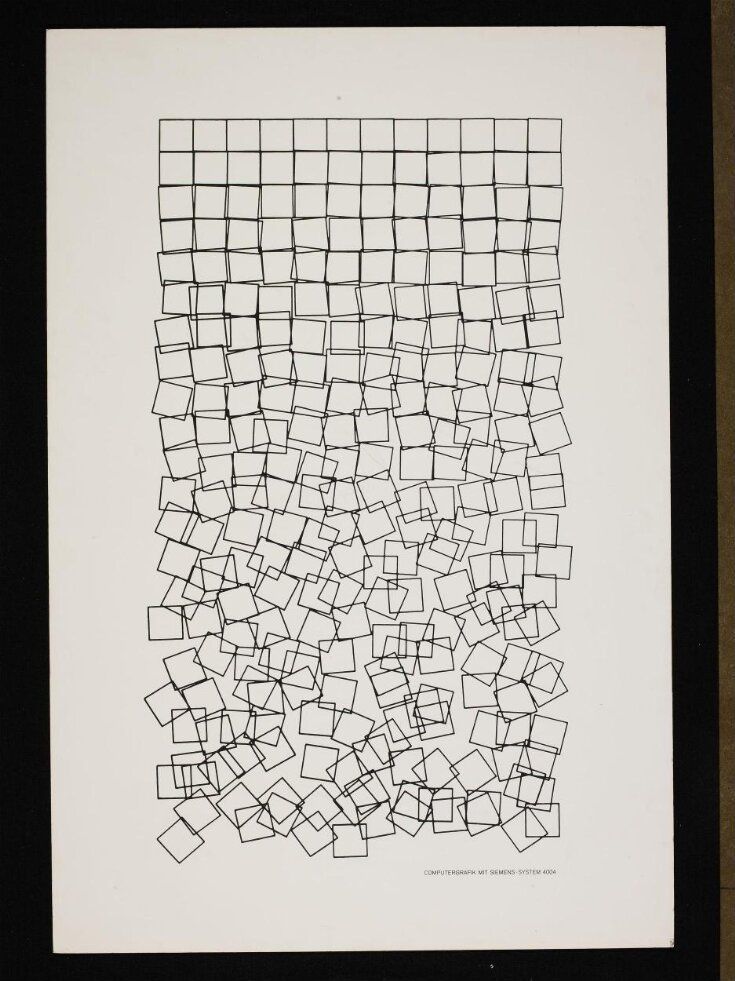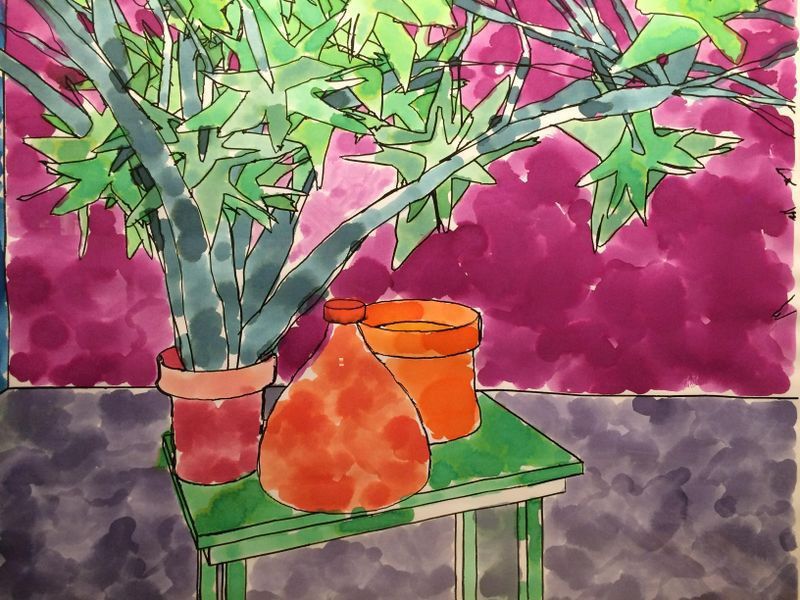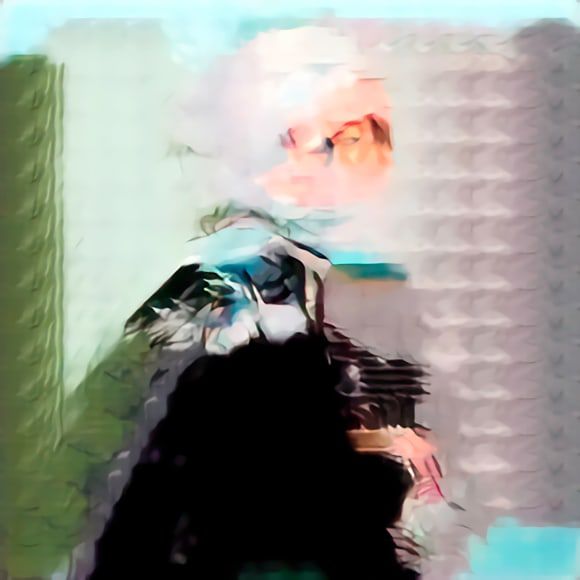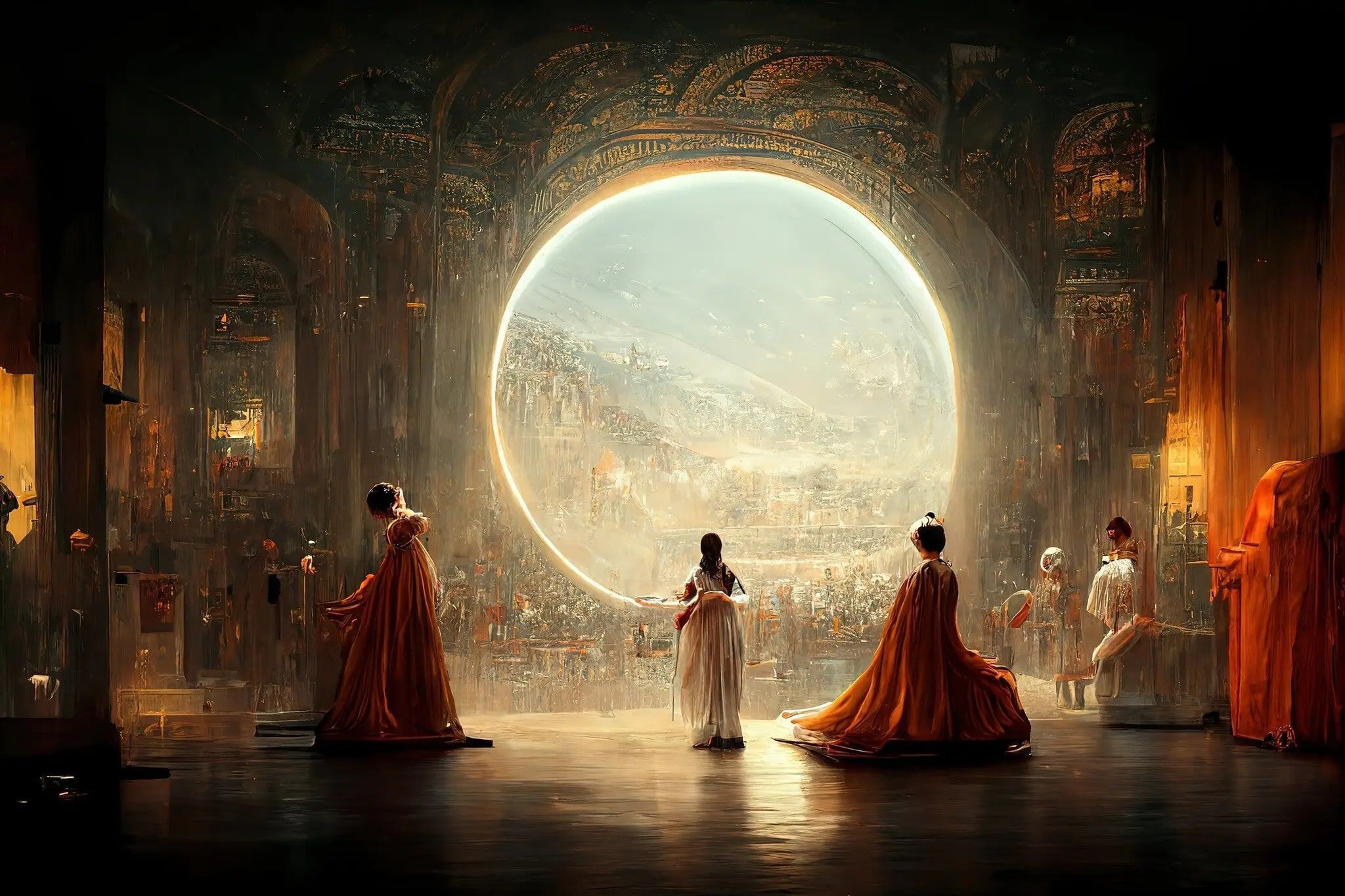When we first think of artificial intelligence, we tend to think of
computers with cognitive abilities that are similar to humans and that
make our lives easier. However, when we add the concept of art to this
definition, it becomes somewhat inadequate. Today, some quarters in the
art world and mainstream view AI-generated art as the latest development
in contemporary art, but to define these autonomous works or
experiences, we need to delve a little deeper. If you're facing
AI-generated art, also known as Artificial Intelligence generated art,
and wondering how we got from Avignon girls to Théâtre D'opéra Spatial,
you may want to have an idea.
When we look at art and art history, we can easily see that it is not a
field where established definitions are always used within certain
boundaries. When we look more closely, the assumed clarity completely
disappears. With the development of modern art, the material and
acquired problem has become the art that is assumed to be outside the
boundaries and the familiar. In today's world, where the boundaries of
what is considered art are constantly expanding, how do we program the
computer to create this independent variable that the artist himself
cannot even specify or define as art? If there is no widely accepted
definition of art, then what should we teach as art so that the
performance can take place meaningfully within the supposed boundaries
of what is considered art?

Pablo Picasso, Les Demoiselles d'Avignon, Paris, June-July 1907
AI Art, in its simplest and basic definition, refers to art produced with the help of artificial intelligence. AI can be defined as machines that imitate human intelligence and simulate the human brain through algorithms, in order to execute commands given to them. They are systems/machines that can repeat and improve themselves without losing their pattern with every new information they acquire. Artificial intelligence today presents itself in many forms and is present in many fields. Systems that are expected to show cognitive functions such as understanding, perception, learning, accumulation, linking different concepts, making inferences, creating thought flow, problem-solving, and communication, and behaviors that are assumed to be unique to individuals, are specifically unique to human intelligence. The English mathematician, computer scientist, and cryptologist Alan Turing, who was one of the mathematicians who tried to solve the Enigma machine's encryption algorithm of the Nazis, and who researched the ability of machines to think - the ability of computers to display intelligent behavior that cannot be distinguished from humans - has had an impact on the development of the concepts of machine intelligence and artificial intelligence.

Alan Turing
AI has long questioned many concepts such as ethics, consciousness, and free will by incorporating philosophers and philosophy into it. With AI-generated art, it has also raised deeper philosophical questions about how it can appeal to senses and emotions through a personal and individual expression method, using a computer and mathematical formula-based algorithm. Although AI art can create unprecedented, unknown, virgin, interesting, and picturesque works, it may not be considered a revolution in terms of art history because it is not created by human mind. In our industrialized and borderless world, it is an important turning point that it can increasingly become widespread and even penetrate into the most personal structures of our lives.
In this era, an artist living today has never seen art change form so quickly and technology and the artist be so closely intertwined in the history of humanity and art. Digital artists are dependent on and work closely with programmers. Each new program and artificial intelligence production has begun to push traditional methods of understanding what creativity is and how art is made beyond their limits. Programs such as Midjourney, Night Cafe and DALL-E 2 create art based on preferences. Only a year ago, portraits created with AI generated art were dull-eyed, blank-faced and grotesque, but now it is possible to create hyper-photorealistic portraits. Artists collaborate with autonomous robots, feeding and training algorithms with data. AI generated art is a collaborative art producer that prevents you from remaining limited in the desire for an unlimited flow of works and the desire for artistic creation.
AI-generated art systems that operate on a prompt-based system direct users to interpret and complete tasks based on pre-trained language models based on their requests. These generators are algorithms that analyze thousands of art works from different artists to create unique works. These results are produced in seconds with no technical expertise required, just the descriptions provided. Another important aspect of the widespread use of AI-generated art is the system's proficiency in the language used. There is no need to create definitions in paragraphs, you can easily connect the sentences or concepts that come to mind. The history of AI-generated art can be traced back to the invention of computers and even the classical philosophers who defined thinking as a symbolic system. The use of computer graphics to create simple colors, shapes, and patterns dates back to the 1950s. These early examples were experimental processes for visual artists exploring the aesthetic perspective on computer screens. We can see that this art, created by computer and algorithm, was performed by artists such as Frieder Nake, Georg Nees, Manfred Mohr, and Vera Molnár, and they have contributed many works.

George Ness, Schotter, Print, 1968-1970

Frieder Nake, no title, 1967
Information aesthetics is based on semiotics and communication theory. It has played a brief but effective role among designers and artists. It is defined as "the theory of aesthetic precision without subjective elements." The goal of this theory is to evaluate the aesthetic values of an artwork algorithmically. When we look at figures in information aesthetics, we encounter Max Bense and Abraham A. Moles. Max Bense is one of the thinkers and writers of post-war Germany. They focused on developing scientific proposals that would bring objectivity to aesthetics. They tried to create a connection between art and rationalism by applying philosophy, physics, and mathematics. This has provided new perspectives on digital art. Since the late 1950s, when artists began to experiment with computer graphics in Bense's laboratory, it is easy to say that they have been using computers to create artwork.

Manfred Mohr, P-300_B, computer-generated ink on paper drawing
Cybernetic Serendipity, which attracted the attention of the national and international press in 1968, was the first international exhibition dedicated to the relationship between art and new technology in the UK. The exhibition brought together composers, engineers, artists, mathematicians, and poets, allowing more than 130 participants to showcase their work. Cybernetic Serendipity, which took place in 1968, a time when our relationship with computers was permeating every aspect of visual culture, is an important step in exploring the relationship between art and technology.

Cybernetic Serendipity Exhibition poster, Institute of Contemporary Art, 2 August – 20 October, 1968
In 1973, English artist Harold Cohen developed a computer program specifically for painting certain objects. Known as AARON, this algorithm system is one of the earliest examples of an autonomous painting generator. Although Cohen coded it to create art in a single style, it is not limited to producing an infinite number of images with that style. For many years, Cohen continued to work on AARON to achieve better results in terms of color or composition.

AARON görüntüsü, Computer Museum, Boston, MA, 1995
As the end of the 20th century approached, the widespread availability of personal computers led to a significant increase in the scope of digital art. By the 2000s, programs such as Github, ImageNet, and Google DeepDream, enabled more active participation in digital art by a wider range of users, including artists.
A key turning point in the evolution of AI art came with the development of Generative Adversarial Networks (GANs). Researchers Ian Goodfellow and colleagues developed GANs as a machine learning technique that could be used to create new images, rather than working on existing images like Google DeepDream. Some of the first artistic applications of GANs were by Alexander Mordvintsev with his DeepDream algorithm.

Mordvintsev, Custard Apple, 2015
What needs to be understood about the program without going too much into the technique is that it has been trained with a large number of x object images, to the point where it can reliably recognize x objects. Based on what the algorithm has learned from this dataset, it is given instructions to generate a completely new x image. Then, images generated by the algorithm are presented to another trained algorithm in order to be able to distinguish them from images produced by humans, until it can be deceived. Although a few people were quick to adopt it, it took a few years for artists to use GAN technology for production purposes. One of the first important points of AI art is the exhibition in 2016 in San Francisco. Here, AI artists like Memo Akten and Mike Tyka exhibited their images. Some artists have trained their productive algorithms in specific visual styles so that they can get the results they want. Artists such as Helena Sarin trained the algorithm with their own drawings, while Anna Ridler used her own photographs.

Refik Anadol, Quantum Memories, Exhibition, Installation, Public Art, Melbourne, AU, 19 Dec 20

Helena Sarin, Latent Doodles

Memo Akten, Distributed Consciousness, 2021
In 2018, the most famous example of GAN-made art is probably the portrait of Edmond de Belamy, created by the French collective Obvious. This portrait was sold at Christie's for a price of $432,500, which is forty times the expected price. The sale of Edmond de Belamy's Portrait is also significant because it is the first AI-generated artwork to be sold at a major auction house. However, this does not mean that AI-generated art has never been sold before. The creation of Edmond de Belamy's Portrait by the Obvious collective has led to debates about how AI-generated art should be conceptualized, the role of AI in this creative process, and the artist identity. Questions about the future of human creativity, plagiarism and ethical concerns were also raised. The artwork is important in terms of its conceptual significance and its high price, it is a significant milestone in history.

Edmond de Belamy'nin Portresi
In a Christie's auction, other AI artists have caught the attention of the public. Following Obvious' success, Mario Klingemann's work titled "Memories of Passersby I" has made a name for itself. "Faceless Portraits Transcending Time" is another AI-created artwork, produced through a collaboration between AICAN and its creator Dr. Ahmed Elgammal. This exhibition is significant in discussing the role of AI in the creative process. AICAN presents its works in a surreal and dream-like manner, depicting themes of fanaticism and representation of the human figure, in two separate series.

Mario Klingemann, Memories of Passersby I

AICAN + Ahmed Elgammal, Faceless Portrait of a Queen, 2019
This year, at the Colorado State Fair's art competition, participant Jason M. Allen created his piece using a machine learning program called Midjourney, which creates hyper-realistic graphics. Allen's work, "Théâtre D'opéra Spatial," became the first AI-generated artwork to win a first place award in such a fair, which sparked intense reactions. Many argued that it wasn't art and that it should not be recognized as such.
As we see more and more evidence of AI's ability to play a creative role beyond just being a tool for artists, it can be argued that this development is driven in part by humanity's admiration for the unique and the never-before-seen. But how much does the possibility of a computer being creative overlap with humanity? While many approaches to AI art tend to be techno-phobic, there are also valid arguments for the potential of AI to enhance technical and cultural possibilities. However, being too preoccupied with fear of what is new and individualistic in this process can hinder us from reaching productive points. It is important to remember that the process of monitoring and directing the evolution is where human influence is effective. Instead of pitting humans against the system, focusing on how humanity can advance with the production of AI in art and how artists can play a defining role will lead to a more productive perspective. Humanity is discovering yet another experience that expands the boundaries of who we are in the universe of aesthetic possibilities through the production of AI in art.

Jason Allen, Théâtre D'opéra Spatial, 2022
Visual Resources:
https://www.moma.org/collection/works/79766
https://www.the-sun.com/lifestyle/tech-old/3160532/alan-turing-inventions-first-computer/
https://collections.vam.ac.uk/item/O221321/schotter-print-nees-georg/
https://www.tate.org.uk/art/artworks/nake-no-title-p80807
https://www.burg-halle.de/design/grundlagen/grundlagen/lehrangebote/l/4d-creative-coding-variation-undinteraktion-6-sw-wintersemester-2223
https://archive.ica.art/whats-on/cybernetic-serendipity-documentation/
https://computerhistory.org/blog/harold-cohen-and-aaron-a-40-year-collaboration/
https://aiartists.org/alexander-mordvintsev
https://refikanadol.com/works/quantummemories/
https://aiartists.org/helena-sarin
https://www.memo.tv/works/distributed-consciousness/
https://www.christies.com/lot/lot-edmond-de-belamy-from-la-famille-de-6166184
https://www.sothebys.com/en/auctions/ecatalogue/2019/contemporary-art-day-auction-l19021/lot.109.html
http://www.hgcontemporary.com/exhibitions/faceless-portraits-transcending-time
https://www.nytimes.com/2022/09/02/technology/ai-artificial-intelligence-artists.html
Content Resources:
1. https://robotart.org/archives/2017/artwork/2780/
2. https://tr.wikipedia.org/wiki/Yapay_zeka_felsefesi
3. Adam Hencz, “Agents Of Change: Artificial Intelligence – AI Art and How Machines Have Expanded Human Creativity” Artland Magazine. Erişim Adresi: https://magazine.artland.com/ai-art/
4. Naomi Rea, Artnet News, 16 Aralık 2021. Erişim Adresi: https://news.artnet.com/art-world/artificial-intelligence-art-history-2045520
5. Fabian Offert, "The Past, Present, and Future of AI Art", The Gradient, 2019. Erişim Adresi: https://thegradient.pub/the-past-present-and-future-of-ai-art/
6. “The golden age of AI-generated art is here. It’s going to get weird”, Financial Times. Erişim Adresi: https://www.ft.com/content/073ea888-20d7-437c-8226-a2dd9f276de4
7. Rohit Kundu, “AI-Generated Art: From Text to Images & Beyond [Examples]”, V7, 25 Ekim 2022,
8. Erişim Adresi: https://www.v7labs.com/blog/ai-generated-art
9. Kieran Browne, “Who (or what) is an AI artist?”, 2020. Erişim Adresi: https://kieranbrowne.com/publications/who_or_what_is_an_ai_artist.pdf
10. Lev Manovich, “Defining AI Arts: Three Proposals” Haziran,2019. Erişim Adresi: http://manovich.net/content/04-projects/107-defining-ai-arts-three-proposals/manovich.defining-ai-arts.2019.pdf
11. Mary McCulla, “Creativity is in the (A)I of the Beholder: Artificial Intelligence and the Visual Arts”, Erişim Adresi: https://ad-hoc-museum-collective.github.io/GWU-museum-digital-practice-2019/essays/essay-7/
12. AI Art, Machine Visions and Warped Dreams, Joanna Zylinska, 2020
13. Frieder Nake, Information aesthetics: an heroic experiment, Erişim Adresi: https://www.researchgate.net/publication/241715762_Information_Aesthetics_An_heroic_experiment
14. https://archive.ica.art/whats-on/cybernetic-serendipity-documentation/
15. https://aiartshop.com/blogs/ai-art-blog/the-origins-of-ai-art
16. https://uploads.strikinglycdn.com/files/3e2cdfa0-8b8f-44ea-a6ca-d12f123e3b0c/AICAN-HG-Catalogue-web.pdf
17. https://www.nytimes.com/2022/09/02/technology/ai-artificial-intelligence-artists.html
This article was written by Mürvet Kalın and published in Piyon Magazine Issue 01 in . You can continue reading the issue by scrolling down. You can read our other issues from the top menu, click here to return to the homepage, or fill out the form in the bottom section to subscribe to our magazine.

Subscriptions Coming Soon